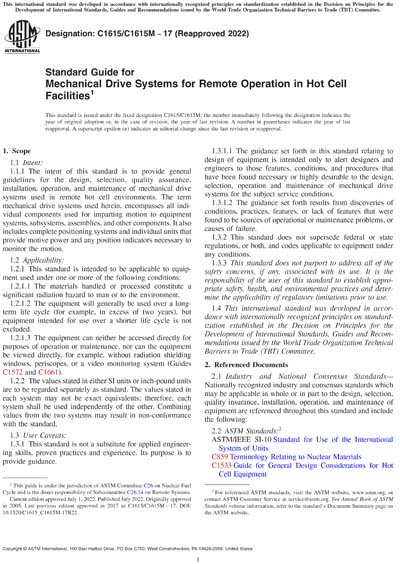Most recent
ASTM C1615/C1615M-17(2022)
Standard Guide for Mechanical Drive Systems for Remote Operation in Hot Cell Facilities
1.1Intent:
1.1.1The intent of this standard is to provide general guidelines for the design, selection, quality assurance, installation, operation, and maintenance of mechanical drive systems used in remote hot cell environments. The term mechanical drive systems used herein, encompasses all individual components used for imparting motion to equipment systems, subsystems, assemblies, and other components. It also includes complete positioning systems and individual units that provide motive power and any position indicators necessary to monitor the motion.
1.2Applicability:
1.2.1This standard is intended to be applicable to equipment used under one or more of the following conditions:
1.2.1.1The materials handled or processed constitute a significant radiation hazard to man or to the environment.
1.2.1.2The equipment will generally be used over a long-term life cycle (for example, in excess of two years), but equipment intended for use over a shorter life cycle is not excluded.
1.2.1.3The equipment can neither be accessed directly for purposes of operation or maintenance, nor can the equipment be viewed directly, for example, without radiation shielding windows, periscopes, or a video monitoring system (Guides C1572 and C1661).
1.2.2The values stated in either SI units or inch-pound units are to be regarded separately as standard. The values stated in each system may not be exact equivalents; therefore, each system shall be used independently of the other. Combining values from the two systems may result in non-conformance with the standard.
1.3User Caveats:
1.3.1This standard is not a substitute for applied engineering skills, proven practices and experience. Its purpose is to provide guidance.
1.3.1.1The guidance set forth in this standard relating to design of equipment is intended only to alert designers and engineers to those features, conditions, and procedures that have been found necessary or highly desirable to the design, selection, operation and maintenance of mechanical drive systems for the subject service conditions.
1.3.1.2The guidance set forth results from discoveries of conditions, practices, features, or lack of features that were found to be sources of operational or maintenance problems, or causes of failure.
1.3.2This standard does not supersede federal or state regulations, or both, and codes applicable to equipment under any conditions.
1.3.3This standard does not purport to address all of the safety concerns, if any, associated with its use. It is the responsibility of the user of this standard to establish appropriate safety, health, and environmental practices and determine the applicability of regulatory limitations prior to use.
1.4This international standard was developed in accordance with internationally recognized principles on standardization established in the Decision on Principles for the Development of International Standards, Guides and Recommendations issued by the World Trade Organization Technical Barriers to Trade (TBT) Committee.
Content Provider
ASTM International [astm]






